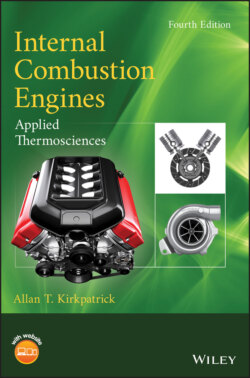Читать книгу Internal Combustion Engines - Allan T. Kirkpatrick - Страница 2
Table of Contents
Оглавление1 Cover
2 Preface
3 Acknowledgements
4 About the Companion Website
5 Chapter 1: Introduction to Internal Combustion Engines 1.1 Introduction 1.2 Historical Background 1.3 Engine Cycles 1.4 Engine Performance Parameters 1.5 Engine Configurations 1.6 Examples of Internal Combustion Engines 1.7 Alternative Powertrain Technology 1.8 Further Reading 1.9 References 1.10 Homework
6 Chapter 2: Ideal Gas Engine Cycles 2.1 Introduction 2.2 Gas Cycle Energy Addition 2.3 Constant Volume Energy Addition 2.4 Constant Pressure Energy Addition 2.5 Limited Pressure Cycle 2.6 Miller Cycle 2.7 Ideal Four‐Stroke Process and Residual Fraction 2.8 Finite Energy Release 2.9 References 2.10 Homework
7 Chapter 3: Thermodynamic Properties of Fuel–Air Mixtures 3.1 Introduction 3.2 Properties of Ideal Gas Mixtures 3.3 Liquid–Vapor–Gas Mixtures 3.4 Stoichiometry 3.5 Chemical Equilibrium 3.6 Low Temperature Combustion Modeling 3.7 Chemical Equilibrium Using Lagrange Multipliers 3.8 Chemical Equilibrium Using Equilibrium Constants 3.9 Isentropic Compression and Expansion 3.10 Chemical Kinetics 3.11 References 3.12 Homework
8 Chapter 4: Thermodynamics of Combustion 4.1 Introduction 4.2 First‐Law Analysis of Combustion 4.3 Second‐Law Analysis of Combustion 4.4 Fuel–Air Otto Cycle 4.5 Four‐Stroke Fuel–Air Otto Cycle 4.6 Limited‐Pressure Fuel–Air Cycle 4.7 Two‐Zone Finite‐Energy Release Model 4.8 Compression Ignition Engine Fuel–Air Model 4.9 Comparison of Fuel–Air Cycles with Actual Spark and Compression Ignition Cycles 4.10 Further Reading References 4.11 Homework
9 Chapter 5: Intake and Exhaust Flow 5.1 Introduction 5.2 Flow Through Intake and Exhaust Valves 5.3 Intake and Exhaust Manifold Flow 5.4 Airflow in Two‐Stroke Engines 5.5 Superchargers and Turbochargers 5.6 Further Reading 5.7 References 5.8 Homework
10 Chapter 6: Fuel and Air Flow in the Cylinder 6.1 Introduction 6.2 Fuel Injection – Spark Ignition 6.3 Fuel Injection – Compression Ignition 6.4 Fuel Sprays 6.5 Gaseous Fuel Injection 6.6 Prechambers 6.7 Carburetion 6.8 Large‐Scale In‐Cylinder Flow 6.9 In‐Cylinder Turbulence 6.10 Further Reading 6.11 References 6.12 Homework
11 Chapter 7: Combustion Processes in Engines 7.1 Introduction 7.2 Combustion in Spark‐Ignition Engines 7.3 Abnormal Combustion (Knock) in Spark‐Ignition Engines 7.4 Combustion in Compression Ignition Engines 7.5 Low Temperature Combustion 7.6 Further Reading 7.7 References 7.8 Homework
12 Chapter 8: Emissions 8.1 Introduction 8.2 Nitrogen Oxides 8.3 Carbon Monoxide 8.4 Hydrocarbons 8.5 Particulates 8.6 Emissions Regulation and Control 8.7 Further Reading References 8.9 Homework
13 Chapter 9: Fuels 9.1 Introduction 9.2 Refining 9.3 Hydrocarbon Chemistry 9.4 Thermodynamic Properties of Fuel Mixtures 9.5 Gasoline Fuels 9.6 Alternative Fuels for Spark‐Ignition Engines 9.7 Diesel Fuels 9.8 Further Reading References 9.9 Homework
14 Chapter 10: Friction and Lubrication 10.1 Introduction 10.2 Friction Coefficient 10.3 Engine Oils 10.4 Friction Power and Mean Effective Pressure 10.5 Friction Measurements 10.6 Friction Scaling Parameters 10.7 Piston and Ring Friction 10.8 Journal Bearings Journal Bearing Friction Journal Bearing Pressure Profile 10.9 Valve Train Friction 10.10 Accessory Friction 10.11 Pumping Mean Effective Pressure 10.12 Overall Engine Friction Mean Effective Pressure 10.13 Further Reading References 10.15 Homework
15 Chapter 11: Heat and Mass Transfer 11.1 Introduction 11.2 Engine Cooling Systems 11.3 Engine Energy Balance 11.4 Heat Transfer Measurements 11.5 Heat Transfer Modeling 11.6 Heat Transfer Correlations 11.7 Radiation Heat Transfer 11.8 Heat Transfer in the Exhaust System 11.9 Mass Loss or Blowby 11.10 Further Reading 11.11 References 11.12 Homework
16 Chapter 12: Engine Instrumentation and Testing 12.1 Introduction 12.2 Instrumentation 12.3 Combustion Analysis 12.4 Exhaust Gas Analysis 12.5 Control Systems in Engines 12.6 Vehicle Emissions Testing 12.7 Further Reading 12.8 References 12.9 Homework
17 Chapter 13: Overall Engine Performance 13.1 Introduction 13.2 Effect of Engine Size, Bore, and Stroke 13.3 Effect of Engine Speed 13.4 Effect of Air–Fuel Ratio and Load 13.5 Engine Performance Maps 13.6 Effect of Ignition and Injection Timing 13.7 Effect of Compression Ratio 13.8 Vehicle Performance Simulation 13.9 Further Reading References 13.11 Homework
18 Appendix A Conversion Factors and Physical Constants
19 Appendix B Physical Properties of Air
20 Appendix C Thermodynamic Property Tables for Various Ideal Gases
21 Appendix D Curve‐Fit Coefficients for Thermodynamic Properties of Various Fuels and Ideal Gases
22 Appendix E Detailed Thermodynamic and Fluid Flow Analyses E.1 Thermodynamic Derivatives E.2 Numerical Solution of Equilibrium Combustion Equations E.3 Isentropic Compression/Expansion with known ΔP E.4 Isentropic Compression/Expansion with known Δv E.5 Constant Volume Combustion E.6 Quality of Exhaust Products E.7 Finite Difference Form of the Reynolds Slider Equation E.8 Reference
23 Appendix F Computer Programs F.1 Volume.m F.2 Velocity.m F.3 BurnFraction.m F.4 FiniteHeatRelease.m F.5 FiniteHeatMassLoss.m F.6 CIHeatRelease.m F.7 FourStrokeOtto.m F.8 RunFarg.m F.9 farg.m F.10 fuel.m F.11 RunEcp.m F.12 ecp.m F.13 AdiabaticFlameTemp.m F.14 OttoFuelAir.m F.15 FourStrokeFuelAir.m F.16 TwoZoneFuelAir.m F.17 Fuel_Injected.m F.18 LimitPressFuelAir.m F.19 ValveFlow.m F.20 Droplet.m F.21 Kinetic.m F.22 Soot.m F.23 TwoZoneNO.m F.24 RingPressure.m F.25 Friction.m F.26 HeatTransfer.m
24 Index
25 End User License Agreement
